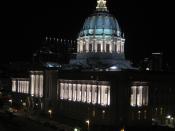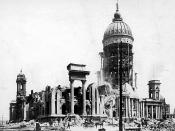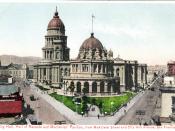San Francisco City Hall
Architecture is not simply a structure that serves as a place of business, religious center, or judiciary hall; rather, it is a device used for communication. Architectural forms and materials, whether they are columns, sculpture, or precious metals, are intended to convey a particular message. For the Greeks, part of this message was of the grandeur of Greek men and their ability to bring order to chaos (as shown through the Parthenon and the Alter of Zeus). The Romans, however, convey a slightly different message through their architecture--that of the power and permanence of the empire (the Forum of Trajan references Roman military might). As millennia passed and classical times became ancient history, the meaning of Greek and Roman Architectural forms changed and took on new meaning for modern man. No longer do these classical architectural forms, so commonly referenced in modern American civic architecture, portray the greatness of Greek men nor the power of the Rome.
Rather, modern man references classical Greek and Roman architectural forms in order to associate himself with the ideals and values of theses great civilizations.
An example of a modern day melding of Greek and Roman architectural forms is the San Francisco City Hall. The structure seems to be a combination of the Roman Basilica and the pantheon with elements of Greek temple architecture. The tri-arched entranceway to the city hall is surmounted by a pediment which is decorated with various sculptural reliefs that adhere to trends in Greek pedimental sculpture (the figures resemble classical forms and recline so as to fit in the corners of the pediment). The pediment is held aloft by six, fluted Doric columns with the outer columns space slightly closer together which is another example of the references made to the Parthenon. Also, the entablature...


